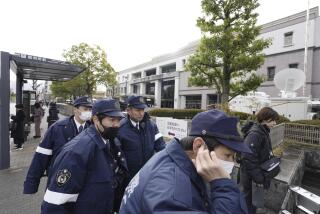Tokyo Police Name Possible Suspect in Subway Attack : Japan: A cult leader is linked to poison-gas incident. Likely attackers’ movements traced.
- Share via
TOKYO — In what could be a major step toward solving the March poison-gas terror attack in the subways here, police Tuesday for the first time named a leader of the Aum Supreme Truth cult as a possible suspect.
Police have also identified the subway stations where at least five people suspected in the attack got off trains shortly before deadly sarin nerve gas began leaking from parcels, quasi-governmental NHK television reported.
The poison killed 12 and afflicted more than 5,500.
Investigators are trying to determine whether Yoshihiro Inoue, 25, head of the cult’s self-styled “intelligence ministry,” had a role in the subway attack, NHK said.
Inoue, who has disappeared along with various other sect leaders sought by the police, was already wanted in connection with the kidnaping of a cult critic.
Authorities believe that Inoue participated in a firebomb attack against Supreme Truth’s Tokyo headquarters the evening before the subway incident, in a move apparently intended to arouse sympathy for the group.
Police have learned that after the firebomb attack, Inoue went to a condominium in Tokyo’s Shibuya ward, then left by car with a group of sect believers, NHK reported Tuesday. Authorities suspect that this group may be linked to the next day’s subway attack.
A confiscated notebook--believed to have been kept by another sect leader, “construction minister” Kiyohide Hayakawa, 45--also provides evidence that the cult had been looking into the possibility of buying tanks in Russia and somehow shipping them to Japan, police confirmed Tuesday.
Kyodo News Service said the notebook also showed that the sect was interested in trying to import nuclear warheads from Russia.
A longer description of the notebook’s contents was recently published in a monthly magazine, which quoted an unnamed police official as stating that the document raises “extreme suspicion” that the sect’s intent was “to challenge the nation of Japan in a war.”
The notebook was seized from a car owned by the sect when police last month arrested Supreme Truth “defense minister” Tetsuya Kibe, 39.
Police so far have arrested more than 150 sect followers, most on minor charges for actions that would normally be ignored. None of those arrested have been accused of involvement in the subway attack.
The confiscated notebook was first believed to be Kibe’s, but police now believe that it was written by Hayakawa, who was arrested April 19 on a trespassing charge. Hayakawa made at least 20 trips to Russia in recent years, Japanese media have reported.
NHK reported Tuesday that the notebook refers to a book on urban guerrilla warfare that advises readers to operate in cells of five or so people. The broadcast report noted that the March 19 firebombing at Supreme Truth’s headquarters and the Feb. 28 abduction of sect critic Kiyoshi Kariya--the case in which Inoue is sought as a prime suspect--apparently were conducted by groups that size.
One alleged participant in the firebombing--sect follower and former Self-Defense Forces sergeant Takahisa Shirai--is already in police custody.
Police say Shirai, 25, has confessed to participating in that incident and has said it was ordered by Inoue to win sympathy for the sect.
Shirai was dismissed by the military on April 28 for allegedly leaking information to the sect about police raids that were to be launched on cult facilities.
On Tuesday, in identifying stations where police believe that perpetrators of the subway attack got off trains, NHK said that one suspect was a man in his 40s wearing a hospital-type mask and that another wore sunglasses and a mask.
More to Read
Sign up for Essential California
The most important California stories and recommendations in your inbox every morning.
You may occasionally receive promotional content from the Los Angeles Times.













